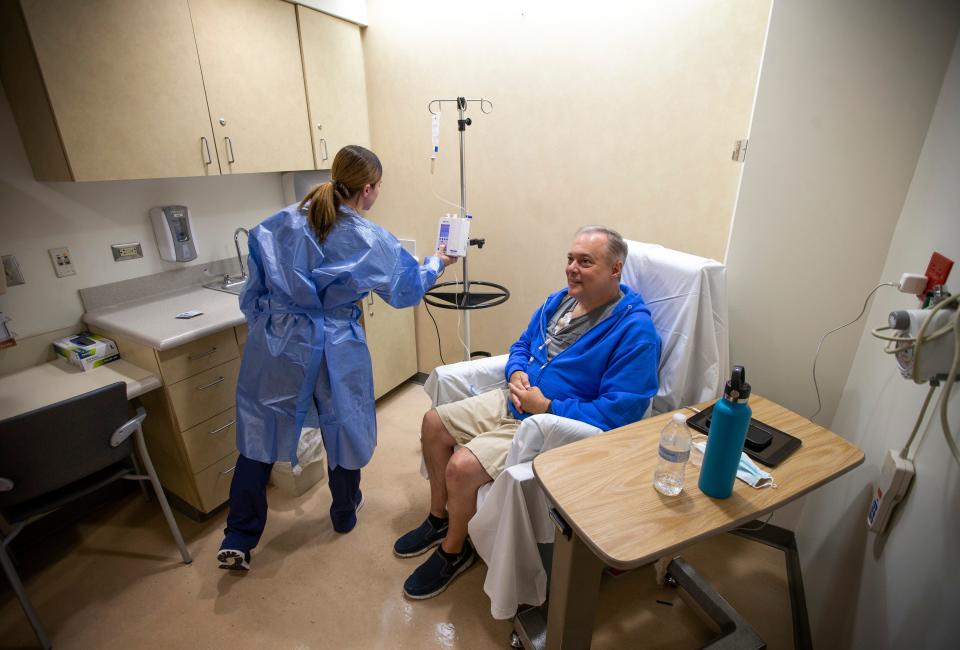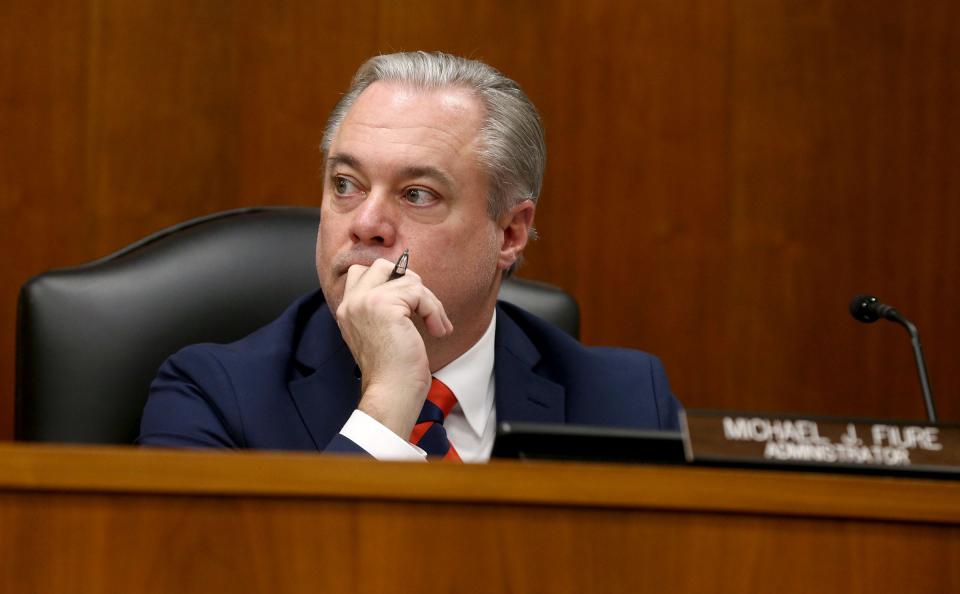Ocean County Administrator Michael J. Fiure undergoing treatment for 2 types of cancer
TOMS RIVER - When Ocean County Administrator Michael J. Fiure was 8 years old, he dug “a cave” in a mound of dirt in his family’s Manville backyard and crawled inside.
When the tunnel collapsed over him, he tried to scream.
“The dirt poured right in my mouth,” Fiure recalled. “That’s the last thing I remembered.”
He lost consciousness. A friend he was playing with, Michael Serafin, could see that Fiure’s legs — sticking out of the mound — had stopped flailing and gone limp. Serafin rushed to get help from a neighbor who was a nurse, an act which ultimately saved Fiure’s life.
In January, Fiure learned that Serafin had died from melanoma the previous month. As with many childhood friendships, their lives had grown apart with Serafin moving to Texas at some point with his family.
His death left Fiure feeling wistful and introspective. If it wasn’t for Serafin, Fiure, who is 51 now, had always understood that his life would have ended on that day back in 1980.
Latest Headlines: Four people hospitalized after half marathon run in Sandy Hook
Exactly one month after Serafin’s death and because of it, Fiure went to see his dermatologist. Four years earlier, Fiure had had a lesion removed from his back and another had reappeared in the same place. He had procrastinated about going for a check-up.

Life was busy. Four months earlier, Fiure had been appointed administrator — a 24/7 job that involves running the day-to-day operation of a county government that serves more people than in the entire state of Vermont. But the passing of Serafin — the same age as Fiure — from a cancer for which he too was at high risk gave him pause.
A biopsy showed that Fiure had malignant melanoma. Like his late childhood friend, Fiure had the most dangerous type of skin cancer.
“What I learned about melanoma also is it could grow (inwards) …. And that’s where the danger is, that’s what happens,” Fiure said. “Because it can get into your blood, it can get into your bones and get into your organs, which I never really thought about. So once they saw that, they immediately recommended surgery.”
More: Toms River's 'Miss Liberty' has never been camera shy. She is now, and needs a hand.
On Feb. 23, Fiure went to Community Medical Center in Toms River to have the melanoma surgically removed, as well as two lymph nodes under his right arm. Three weeks after that, he went for positron emission tomography and computed tomography (PET-CT) scans.
He was referred to Dr. Jessica Taff, a local hematologist oncologist, who found something additionally disturbing.
“When he was sent to me, we got imaging just to see the stage of his melanoma — even though he had already had surgery — and very surprisingly, his body was full of lymph nodes, which wouldn’t necessarily have been common for what we thought his stage of melanoma was,” Taff said. “So, we biopsied those lymph nodes and it came back as Hodgkin's lymphoma; which is very, very uncommon to have these two malignancies.”
The Mayo clinic describes Hodgkin’s lymphoma as a type of cancer that affects the lymphatic system, the body's germ-fighting immune system. In Hodgkin’s lymphoma, white blood cells called lymphocytes grow out of control, causing swollen lymph nodes and growths throughout the body.
There are two kinds of lymphoma — non-Hodgkin's lymphoma and Hodgkin's lymphoma, which used to be called Hodgkin's disease. Both diseases are a type of cancer that begins in white blood cells called lymphocytes. Lymphocytes are an important part of the immune system. The main difference between Hodgkin’s lymphoma and non-Hodgkin’s lymphoma is in the specific lymphocyte each involves, all according to the Mayo Clinic.
The combination of melanoma and Hodgkin’s lymphoma was something Taff said she had never seen before, and is perhaps just an unlucky coincidence as there is no genetic link between the cancers.
Had Fiure not seen a doctor when he did, Taff said it might have been months or even years before he experienced symptoms. Typically, patients who are later diagnosed with this type of cancer see a doctor after they have developed painless lumps or bumps in their necks, in their armpits or on their groins — accompanied by fevers, chills and night sweats. A number of patients report that they wake up in the middle of the night drenched in perspiration to the extent they have to change their bedsheets, pillows or their nightwear. But Fuire had experienced none of that, Taff explained.
“He had zero symptoms,” she said.
As such, his prognosis is good. Fiure is on a combination of chemotherapy and immunotherapy. His treatment for Hodgkin’s is expected to finish up this month, but he will undergo treatment for the melanoma into 2024. A period of what is called “surveillance” will follow, where Fiure will repeatedly go for check-ups in search for any sign of recurrence.
With chemotherapy and immunotherapy, Fiure is treated twice a month at Community with a cocktail of four medications. He is also prescribed steroids and anti-nausea medications to treat the side effects of the treatment — which results in physical exhaustion and makes some sick to their stomachs.

“We’re lucky in that Hodgkin’s is a very treatable disease, but clearly, as it becomes more advanced, it becomes more difficult to treat,” Taff said. “So luckily, we found it early and it’s very survivable. And he already had his interim scans, which showed a complete remission.”
Fiure himself is upbeat and optimistic. He approaches his treatment in the same goal-driven, numbers-focused and methodical manner in which he has always approached his career.
“There’s so much going on between, you know, my family, home life, work,” Fiure said. “I don’t have time just to dwell on negative things or what could be, or, ‘oh my God, what’s gonna happen?’ … All I can focus on is what’s in front of me. Like I said, we have a great, great treatment plan. Obviously, our intermediate results have been good, so far.”
Fiure said Serafin saved his life — again.
“I always say that my friend saved my life, but it wasn’t the first time,” Fiure said.
Fiure, who was fit and athletic at the time of his diagnosis, is chronicling his battle with cancer on Facebook and hopes that his story will serve as a lesson to anyone who has been putting off that doctor’s appointment; or ignoring that mark, that lump, that ache or that cough that hasn’t gone away.
“I didn’t set out to be so open when this happened, but I always want to try to help others and I couldn’t think of any other way,” Fiure said.
Contact Asbury Park Press reporter Erik Larsen at elarsen@gannettnj.com.
This article originally appeared on Asbury Park Press: Ocean County NJ administrator wages battle against 2 types of cancer

